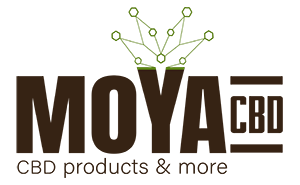A Complete Guide to Understanding Cannabidiol
Cannabis SATIVA L, which is consumed by smoking or eating, has been used for thousands of years in traditional medicine on various continents to relieve pain, the most prominent of which was facilitating labour contractions in new-borns and curing common digestive diseases.
The main reasons for the use of the cannabis plant were the relief of pain symptoms and also the prevention of nausea, vomiting, seams and loss of appetite.
It recently became apparent that the general mood of the patients also improved with the help of the cannabis plant and the patients gained some control over the intensity of disease symptoms in different parts of their digestive system.
The continuous use of the cannabis plant weakens abdominal pain, prevents diarrhoea, heart attacks, nausea and vomiting, eliminates microorganisms and intestinal parasites, and as a result improves the quality of life of patients. The side effects of cannabis are mild compared to the severe side effects caused by the synthetic conventional drugs.
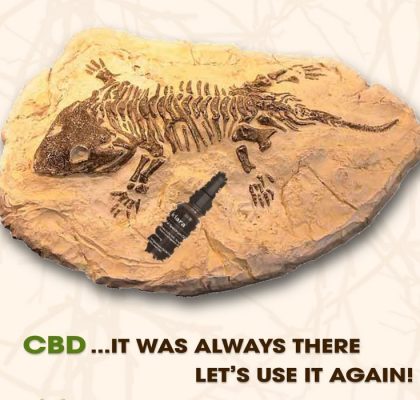
For hundreds of thousands of years, knowledge of the cannabis plant has traditionally passed, but it was not until 1939 that the American chemist Roger Adams approached the marijuana research project during which he first isolated the molecule cannabidiol (CBD) from the rest of the plant’s components, where modern research of cannabis began.
When CBD oil was first detected and isolated in the laboratory, the scientists assumed that cannabidiol had little (if any) effect on the human body. In those years, the prohibition on the cultivation of marijuana and the outlawing of marijuana in the United States absurdly made the psychoactive effect of cannabis more sought after, both for research and consumption.
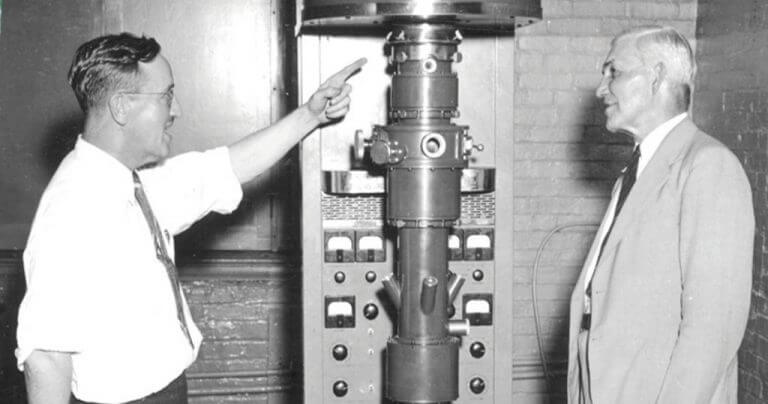
Pictured: American chemist Roger Adams (left) and the first CBD isolation facility in 1942.
Indeed, the research in those years focused mainly on the study of the medicinal effects of THC, which was identified, isolated and synthesized in a laboratory at the Hebrew University of Jerusalem in 1964 by Prof. Raphael Mechoulam (known as the Father of Cannabis Research) and Professor Yehiel Gaoni.
30 years later, in the 1990s, a research team led by Professor Raphael Mechoulam discovered the presence of the Endocannabinoid System (ECS) in the human body. Which consisted of LIGANDS (which are a stimulating agonist or oppressive antagonist) and this discovery caused the great change.
To date, 167 different phytocannabinoids (Phyto = plant) have been found in the cannabis plant, about 200 terpenes and terpenoids, several dozen flavonoids and hundreds of other substances, most of which have not yet been studied.
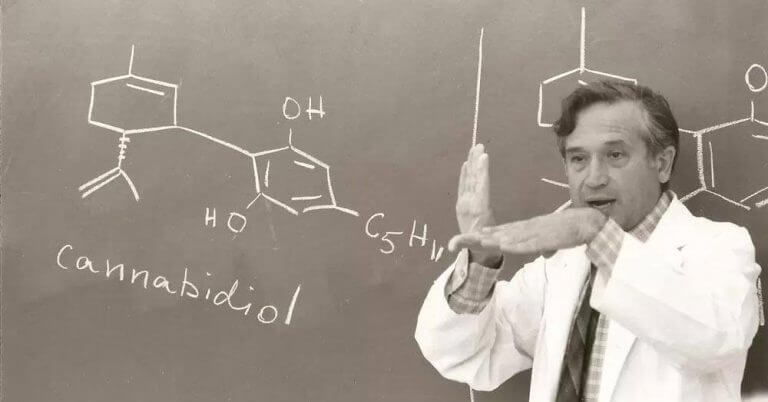
Pictured: Professor Raphael Meshulam, father of cannabis research, explains for the first time to his students about the properties of cannabidiol in the mid-1960s
The Phytocannabinoids are hydrophobic and therefore soluble in oil and are infured with the help of a polar solvent. Of the 167 Phytocannabinoids, the three most common plants have been studied to date:
- Tetrahydrocannabinol (THC),
- Cannabidiol (CBD),
- Cannabigerol (CBG)
Since the plant’s main psychoactive component (THC) has strong psychological effects in man, such as: euphoria, change in sensory perception, decreased motor function and short-term memory impairment, science and research in non-intoxicating cannabidiol (NON-INTOXICATING) has focused in recent years on its role in the Endocannabinoid System in the human body.
What is CBD: The Unique Mechanism of Action of the Phytocannabinoids
The Endocannabinoid System is a neural communication system that exists in various animals, including mammals, and connects chemicals (cannabinoids) secreted naturally in the body with receptors found mainly in the nervous system and immune system. In order to understand the uniqueness of cannabidiol, one must first understand which cannabinoids exist:
- Phytocannabinoids – (Phyto =from the plant) Cannabinoids found in the cannabis plant (hemp, marijuana) itself.
- Synthetic Cannabinoids – Created in the laboratory by hand, some with a molecular resemblance to natural phytocannabinoids and some without structural similarities – but they bind to the target proteins.
- Endocannabinoids – (endo = from the body) Cannabinoids formed in the human body, fatty acids of which are best known are anandamide (the “inner happiness” molecule) and endocannabinoid 2-AG.

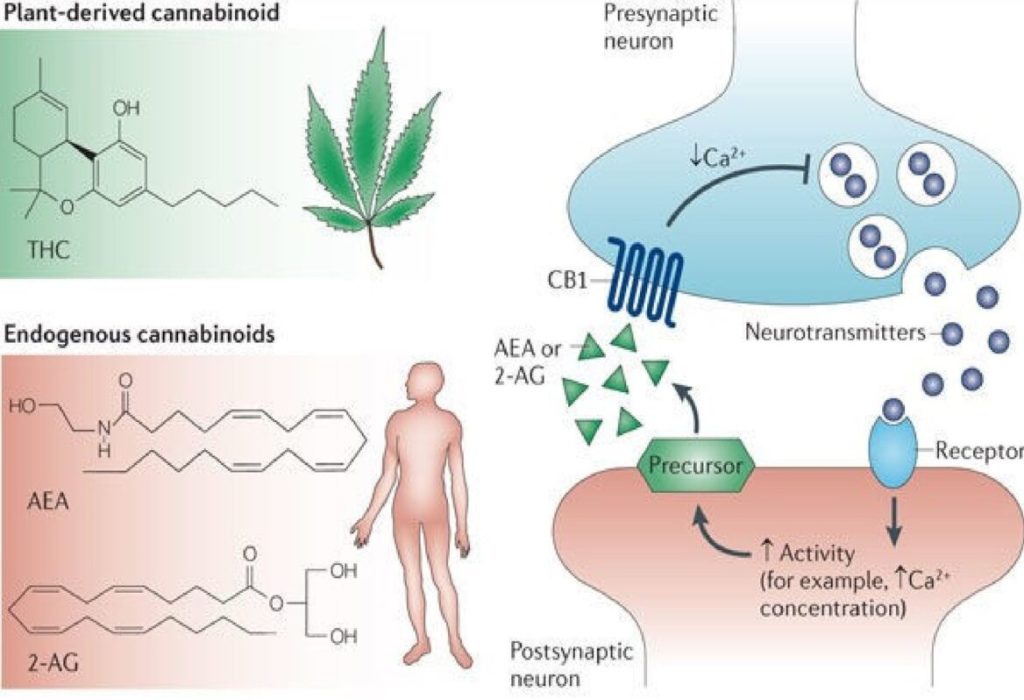
Picture Callout
Endocannabinoid is produced in the post-synaptic nerve cell while the appropriate receptor is found in the presynaptic nerve cell. In nerve cells that release the soothing neurotransmitter Gamma-aminobutyric acid (GABA) the cannabinoids will prevent (suppress) further release of the soothing neural messenger and thus the overall effect will be stimulating. In nerve cells that release the stimulant neurotransmitter Glutamate (GLU) the cannabinoid will suppress and prevent the release of the stimulant neurotransmitter and thus the overall effect will be soothing. The endo-cannabinoid system in the human body serves as a modulatory system, and its main function is to bring the body and mind into balance— homeostasis.
It is this balance that allows the body to work in the most healthy way. When the person consumes the phytocannabinoids (from the cannabis plant) in smoking evaporation or eating, the endocannabinoid system in his body is “flooded” with “external” cannabinoids. Despite the obvious differences in their chemical structure, both endo-cannabinoids (inside our bodies) and some of the phytocannabinoids (which come from the plant) are associated with the same receptors in our bodies. (This is a rare phenomenon that does not yet have a comprehensive scientific explanation)
The THC molecule is associated with a high affinity with CB1 and CB2 receptors, while CBD has not been linked to them at all – and its mechanisms of action differ and are not related to these receptors.
The Uniqueness Of CBD
CBD is a phytocannabinoid that is a trapeno-phenolic molecule made of 21 carbon atoms, which is formed as a result of de-carboxylation (co² heating in the presence of oxygen) from the substance of origin – cannabigerolic acid (CBDA) and is not linked to the receptors of the CB1 or CB2 system but acts through a large number of other mechanisms of action that are recently revealed in the scientific study.
Cannabidiol does not cause intoxicating effects (non-Intoxicating) and does not feel the feeling of elation (High) in its effect at all. On the contrary, cannabidiol has a calming general effect, which prevents anxiety and psychosis while simultaneously suppressing inflammation throughout the body and soothing pain, nausea and vomiting.
Where does CBD come from?
Hemp is a cannabis plant that contains high concentrations of CBD and extremely low concentrations of THC – up to 0.3% and is legal and approved for use in many countries (and their number is steadily increasing), so most of the oils containing CBD currently on the market are derived from the hemp plant.
CBD can be produced completely synthetically, from substances unrelated to the cannabis plant.
Theoretically, CBD can be transformed into THC under laboratory conditions, but this reversal is inseparable (in terms of intolerant effect) in patients who consume CBD in normal digestive processes, in any way possible consumption (smoking, swallowing, evaporation, etc.).
The anti-inflammatory properties of CBD have been shown in many clinical studies as well as in cultured cells and many mechanisms of action have been exposed that work concurrently on about 60 different target proteins (receptors, ion channels, carrier proteins and enzymes) and therefore cannabidiol is considered a “per Permitous drug”.
Modern medical sciences and pharmacies prefer a drug that is one molecule and a single target protein, thus also manifesting the lack of many drugs. (The body develops resilience, dependence and addiction).
In contrast, in 2017, the World Health Organization (WHO) determined that CBD is not toxic, has no intoxicating effects, and does not cause a feeling of obstetrics. WHO added that CBD is a potentially non-dangerous drug, safe to use and has few possible side effects. Dozens of countries around the world are already in the process of changing national control in order to obtain CBD oil as a medical product. To date, there is no evidence of the use of CBD for recreation of “criminal” social use or abuse and the creation of dependence, and no public health problems and morbidity associated with the use of CBD have been found.
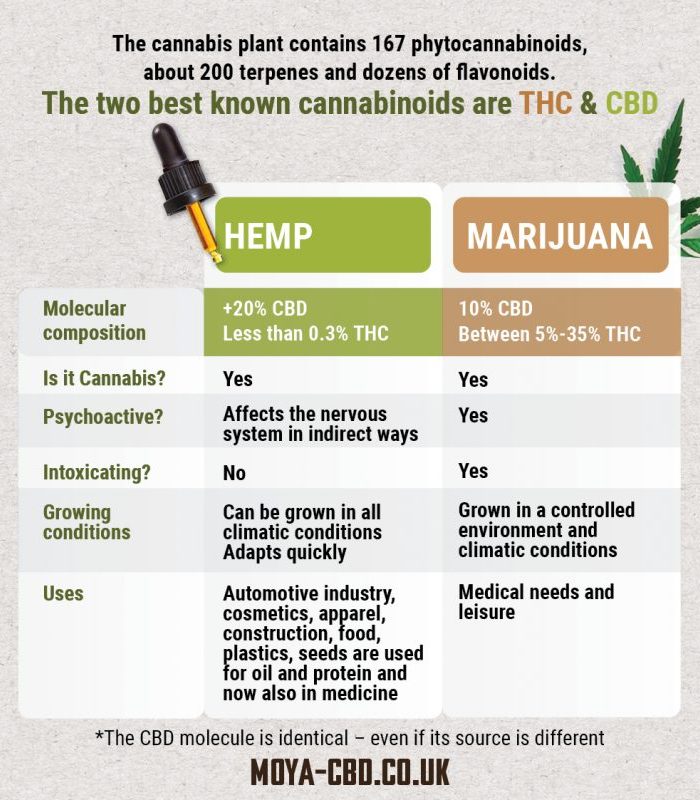
What is the Endocannabinoid system in relation to CBD?
Cannabinoids (CBD) affect all human body as a result of linking to Endocannabinoid receptors (internal) across the membranes of different cells.
Two Endocannabinoid receptors are known:
- CB1 (central) found in the brain and nervous system at high concentrations
- CB2 (peripheral) found mainly in the periphery and immune cells
Our bodies have Endocannabinoids that are naturally produced molecular compounds in the body. Endocannabinoids are bind and activate the two cannabinoid receptors in our bodies.
The best known Endocannabinoids are:
- Anandamide (ANA) – N-arachidonoylethanolamine (AEA)
- 2-Arachidonoylglycerol – (2-AG)
Despite the obvious differences in their chemical structure, both Endocannabinoids and some Phytocannabinoids bind to the same receptors in our bodies: The THC has been associated with high affinity for CB1 and CB2 receptors while CBD has not been linked to them at all and its mechanisms of action differ and are not related to these receptors.
The pharmacological activity of the CBD is very interesting. Although it does not work directly on CB1 and CB2 receptors, it has the ability to block the activity of certain compounds that activate these receptors, such as THC. This trait of CBD is important as it may suppress the psychoactive effects of THC which may be beneficial for those who use THC to treat pain and convulses.
Reducing the psychoactive effect will reduce the side effects of THC and medicinal cannabis and this balance can be maintained by providing CBD as a supplement to the medical prescription.
Today there is many evidence and evidence that supports the theory of “clinical Endo-cannabinoid deficiency” (Dr. Eitan Russo) mainly in diseases such as migraine, PTSD, fibromyalgia, and irritable bowel syndrome (IBS). CBD and CBDA are considered compounds that balance this system in the most effective way, and the evidence of their many healing abilities and properties only increases by the day. Studies dealing with CBD and CBDA occur at any given moment and a large number of pharmacological targets have already been revealed.
CBD Mechanisms Of Action
Inhibition of the Decomposition of Endocannabinoids
The enzyme Fatty Acid Amide Hydrolase (FAAH) breaks down anandamide and 2-AG and thus ends their operation with synapse quickly. Cannabidiol inhibits this enzyme FAAH and thus increases the pain relief and soothing activity of endocannabinoids through the endocannabinoid receptors. FAAH is an enzyme responsible for the activity of the anandamide. CBD inhibits the activity of this enzyme.
In this way the CBD returns the anandamide to a normal level (by stopping the decomposition), and returns the endocannabinoid system to balance.
A medical study examining the effect of CBD on schizophrenia patients showed that cannabidiol caused an increase in anandamide levels, resulting in medical improvement in those patients.
Antioxidant Activity Activity against Reactive Oxygen Species (ROS) which damage cells in different tissues and stimulate inflammatory processes and pain. The U.S. government’s patented listing of cannabidiol’s antioxidant properties can be found in the following link: Cannabinoids as antioxidants and neuroprotectants
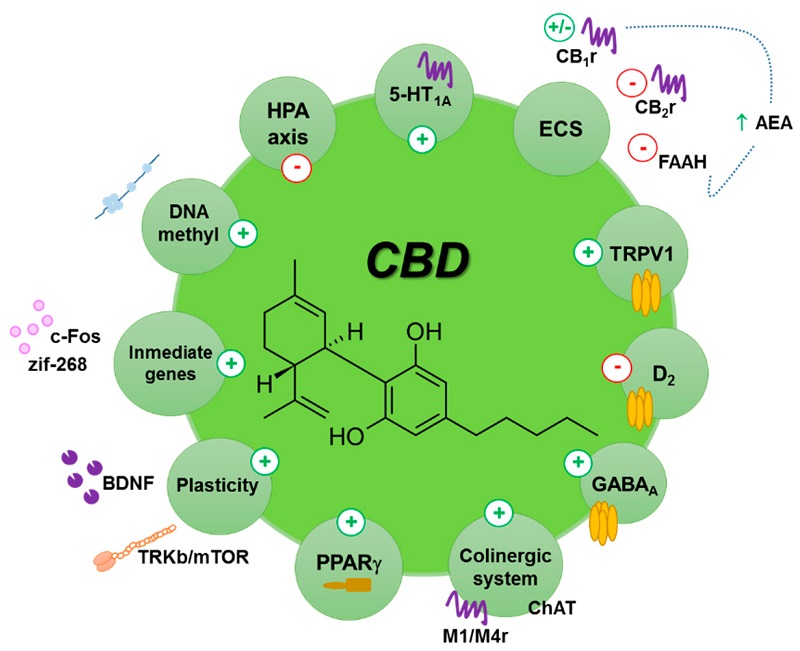
More CBD Mechanisms Of Action:
- Anti-inflammatory Activity – Activity manifested in suppression of cytokine release (Cytokines) and interleukines, which encourage inflammatory processes from immune cells.
- Action of Receptors – The action of receptors in cell nuclei Peroxisome Proliferator Activated Receptors (PPARS) and transcription factors that monitor the expression of many PPARS genes expressed on the cell nucleus envelope, Monitors the development, differentiation, metabolism of carbohydrates, proteins and fats, as well as malignant cancer processes. Cannabidiol activates PPARS and prevents the development of malignant cells and the formation of harmful proteins (Amyloid Plaque Beta) in the brains of Alzheimer’s disease patients, including inflammation of the brain and digestive system.
- Operation and opening of cation channels Transient Receptor Potential Vanniloid = TRPV-1 responsible for recession of pain, body temperature and inflammation. The action of this receptor/ion canal by CBD calms the feeling of pain, suppresses inflammatory processes and lowers body temperature.
- Activating the 5HT1A Receptor – (Hydroxy tryptamine serotonin receptor) affects as an antidepressant, nausea and anxiety. This effect is intensified by the activation of the Adenosine receptor by CBD. It is important to emphasize that cannabidiol has not been associated at all with other syotronergic receptors like 5HT2A or 5HT3A that cause hallucinations.
- The action of the “orphaned” receptors Which are: GPR18 GPR55 GPR119 = G-protein-coupled receptor (GPCR). In conclusion – CBD intake allows those internal cannabinoids to remain in our bodies for longer, which supports and strengthens the endocannabinoid system.
Is CBD Recommended For Everyone?
Adults: People with a high-risk medical condition taking medications with severe side effects should consult a doctor before using CBD.
Children: In no way do we recommend the taking of cannabis by those who have not turned 18 by law. Medical cannabis studies are inconclusive about its possible effects on brain and central nervous system development on children who are still in the developmental stage of their bodies when using cannabis. Although CBD is not intoxicating, it is not true to say that it has no psychoactive effects. Taking CBD by minors should be carried out in consultation with a doctor and sole responsibility of the parent.
Pregnant women: We do not recommend in any way to take CBD during pregnancy. Despite the high “safety profile” of the CBD no studies have yet been done on the subject and without denying any possibility of possible harm to the foetus – there is no need to take unnecessary risks. Perhaps this is the place to note that there is a severe negative effect of THC on the brain development of the foetus.
Animal: In most animals there is an endocannabinoid system that is responsible as in man for the balance between body and mind. The mechanisms of action of CBD in animals are the same as the mechanisms of action of the person and therefore the effect of CBD on animals will be beneficial and desired mainly for animals with inflammation, joint pain and aging.
However, insufficient studies have yet been done on the effect of CBD on animals, the desired dose according to body weight, etc., and therefore any treatment of animals is required in consultation with a veterinarian. It’s worth knowing that dog breeds are very sensitive to cannabinoids because of their genetic makeup.
Side Effects Of CBD
You should be aware of the possible side effects before putting CBD into our diary routine. While the possible side effects are minimal, it is important to remember that the substance may affect everyone in a different way, and what happens to one will not necessarily happen to another, so it is important to start with a low dose that increases gradually. Here’s how to notice side effects, if any, and reduce the dose back if there are one or more of the following side effects:
Thirst or dry mouth A study conducted in 2006 indicates that cannabinoid receptors are also found in cells that secrete salivary fluid, so that when CBD affects the activity of the endocannabinoid system the salivary glands have difficulty forming saliva.
Decrease in blood pressure When taking CBD at high doses, there is a chance of a decrease in blood pressure. It is recommended to consult a doctor before consuming CBD oil in case of blood pressure problems or in combination with medications to regulate blood viscosity.
Drowsiness and provocation Because CBD consumption affects different people differently, arousal or drowsiness are possible side effects in the first few days of use of the product. In case CBD consumption causes drowsy, avoid running heavy equipment or driving, and it is recommended to reduce the dose to a level that does not cause drowsy in the middle of the day.

